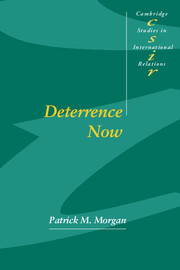Book contents
- Frontmatter
- Contents
- Acknowledgments
- List of abbreviations and acronyms
- Preface
- 1 History: deterrence in the Cold War
- 2 Deterrence and rationality
- 3 General deterrence
- 4 Testing, testing, one … two … three
- 5 Collective actor deterrence
- 6 The revolution in military affairs and deterrence
- 7 Deterrence in the post-Cold War world
- 8 Some conclusions
- References
- Index of names
- Index of subjects
- CAMBRIDGE STUDIES IN INTERNATIONAL RELATIONS
5 - Collective actor deterrence
Published online by Cambridge University Press: 22 September 2009
- Frontmatter
- Contents
- Acknowledgments
- List of abbreviations and acronyms
- Preface
- 1 History: deterrence in the Cold War
- 2 Deterrence and rationality
- 3 General deterrence
- 4 Testing, testing, one … two … three
- 5 Collective actor deterrence
- 6 The revolution in military affairs and deterrence
- 7 Deterrence in the post-Cold War world
- 8 Some conclusions
- References
- Index of names
- Index of subjects
- CAMBRIDGE STUDIES IN INTERNATIONAL RELATIONS
Summary
We turn now to a topic seldom addressed in analyses of deterrence. Few analysts who examine collective actor peacekeeping and peace enforcement endeavors employ a deterrence perspective. Until recently those endeavors were typically confined to interventions with which the conflicting parties concurred and the coercive measures were limited to sanctions. Now we have a global system and several regional systems where forceful security management by collective actors is prominent and promises to grow in importance, management with a deterrence component. It seems worthwhile to begin exploring the features of deterrence when used by collective actors.
Collective actors
A collective actor is a cluster of states established and designed to decide and act for the general welfare. The term is awkward since alliances are – in a sense – collective actors and I do not mean to discuss alliances here. My target is actors constructed and charged to act for the general welfare, the collective good, as opposed to pursuing member interests only. The topic is the use of deterrence by such actors in attempting to maintain peace and security for an international system (regional or larger). This can include the use of force when deterrence fails and threats must be implemented. There is now a notable level of this multilateralism, including threats to induce acceptable behavior and force to compel it.
The contemporary epitome at the global level is the UN Security Council, an institutionalized great-power concert charged with maintaining peace and security.
- Type
- Chapter
- Information
- Deterrence Now , pp. 172 - 202Publisher: Cambridge University PressPrint publication year: 2003
- 2
- Cited by

